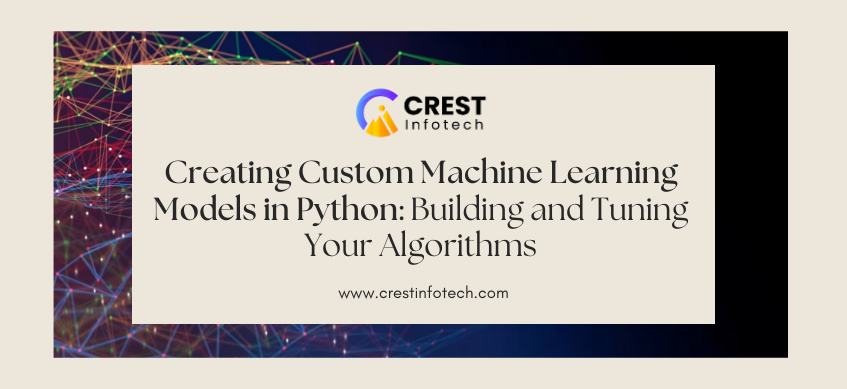In the realm of artificial intelligence (AI) and machine learning (ML), Python has emerged as the go-to programming language for developing robust and efficient models. Its rich ecosystem of libraries and frameworks makes it easier to build, train, and fine-tune machine learning algorithms. In this article, we’ll explore how to create custom ML models in Python, from foundational steps to advanced tuning techniques.
Step 1: Define the Problem and Collect Data
Before diving into coding, clearly define the problem you’re solving. Is it a classification task, regression problem, or clustering exercise? Once defined, the next step is to collect and preprocess the data.
# Example: Importing libraries for data handling
import pandas as pd
from sklearn.model_selection import train_test_split
# Load dataset
data = pd.read_csv("data.csv")
# Split data into training and testing sets
X = data.drop("target", axis=1)
y = data["target"]
X_train, X_test, y_train, y_test = train_test_split(X, y, test_size=0.2, random_state=42)Step 2: Choose a Model Architecture
Python offers a variety of options for implementing custom models. Here’s how to build a basic model using scikit-learn and extend it with a custom implementation if needed.
Using Built-In Models:
from sklearn.ensemble import RandomForestClassifier
# Initialize model
model = RandomForestClassifier(n_estimators=100, random_state=42)
# Train the model
model.fit(X_train, y_train)Building a Custom Model:
For advanced use cases, you can define your algorithm by leveraging libraries like NumPy or TensorFlow.
import numpy as np
class CustomLinearRegression:
def __init__(self, learning_rate=0.01, epochs=1000):
self.learning_rate = learning_rate
self.epochs = epochs
self.weights = None
self.bias = None
def fit(self, X, y):
n_samples, n_features = X.shape
self.weights = np.zeros(n_features)
self.bias = 0
# Gradient Descent
for _ in range(self.epochs):
y_pred = np.dot(X, self.weights) + self.bias
dw = (1 / n_samples) * np.dot(X.T, (y_pred - y))
db = (1 / n_samples) * np.sum(y_pred - y)
self.weights -= self.learning_rate * dw
self.bias -= self.learning_rate * db
def predict(self, X):
return np.dot(X, self.weights) + self.biasStep 3: Evaluate and Validate
Evaluation metrics help ensure the model’s performance aligns with expectations. Python’s libraries make it straightforward to validate your results.
from sklearn.metrics import accuracy_score, mean_squared_error
# For classification
predictions = model.predict(X_test)
accuracy = accuracy_score(y_test, predictions)
print(f"Accuracy: {accuracy}")
# For regression
mse = mean_squared_error(y_test, predictions)
print(f"Mean Squared Error: {mse}")Step 4: Hyperparameter Tuning
Tuning hyperparameters can significantly improve your model’s performance. Use techniques such as grid search or random search to find the optimal settings.
from sklearn.model_selection import GridSearchCV
# Define hyperparameter grid
param_grid = {
'n_estimators': [50, 100, 200],
'max_depth': [None, 10, 20, 30],
'min_samples_split': [2, 5, 10]
}
# Initialize Grid Search
grid_search = GridSearchCV(estimator=RandomForestClassifier(random_state=42),
param_grid=param_grid, cv=5, scoring='accuracy')
# Fit Grid Search
grid_search.fit(X_train, y_train)
print(f"Best Parameters: {grid_search.best_params_}")Step 5: Deploy and Monitor
Once satisfied with the model’s performance, deploy it using frameworks like Flask or FastAPI for real-time predictions. Continuous monitoring ensures the model’s accuracy remains consistent.
from flask import Flask, request, jsonify
app = Flask(__name__)
@app.route('/predict', methods=['POST'])
def predict():
input_data = request.json["data"]
prediction = model.predict([input_data])
return jsonify({"prediction": prediction.tolist()})
if __name__ == '__main__':
app.run(debug=True)Conclusion
Creating custom machine learning models in Python requires a blend of theoretical understanding and practical skills. By leveraging Python’s extensive library ecosystem, you can efficiently build, tune, and deploy models tailored to your specific needs. With consistent practice and exploration, you’ll be well-equipped to tackle increasingly complex machine learning challenges.



